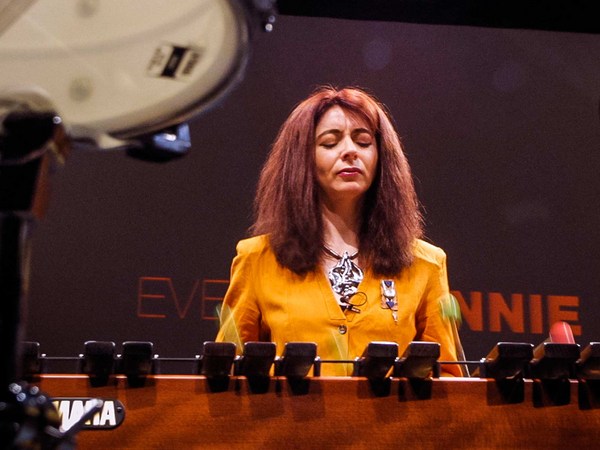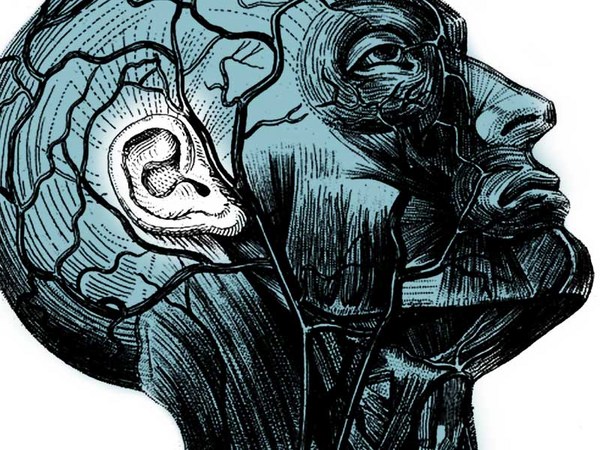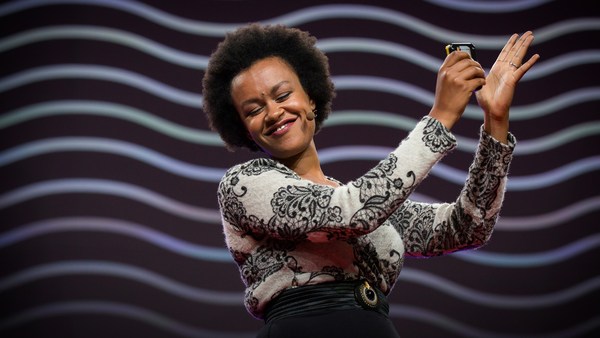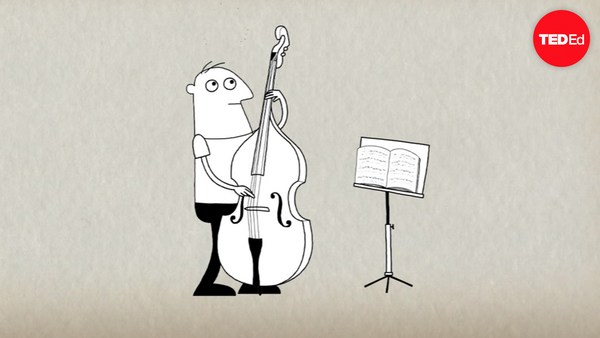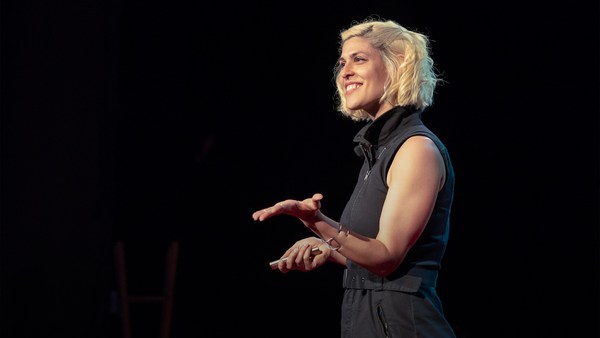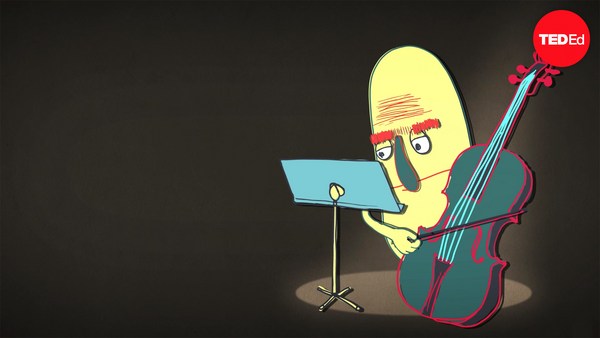So I am a surgeon who studies creativity, and I have never had a patient tell me, "I really want you to be creative during surgery," and so I guess there's a little bit of irony to it. I will say though that, after having done surgery a lot, it's similar to playing a musical instrument. And for me, this deep and enduring fascination with sound is what led me to both be a surgeon and to study the science of sound, particularly music. I'm going to talk over the next few minutes about my career in terms of how I'm able to study music and try to grapple with all these questions of how the brain is able to be creative. I've done most of this work at Johns Hopkins University, and at the National Institute of Health where I was previously. I'll go over some science experiments and cover three musical experiments.
I will start off by playing a video for you. This video is of Keith Jarrett, who's a well-known jazz improviser and probably the most well-known, iconic example of someone who takes improvisation to a higher level. And he'll improvise entire concerts off the top of his head, and he'll never play it exactly the same way again, so as a form of intense creativity, I think this is a great example. And so why don't we go and click the video.
(Music)
(Music ends)
It's really a remarkable thing that happens there. I've always as a listener, as a fan, I listen to that, and I'm astounded. I think -- how can this possibly be? How can the brain generate that much information, that much music, spontaneously? And so I set out with this concept, scientifically, that artistic creativity, it's magical, but it's not magic, meaning that it's a product of the brain. There's not too many brain-dead people creating art. With this notion that artistic creativity is in fact a neurologic product, I took this thesis that we could study it just like we study any other complex neurologic process, and there are subquestions that I put there. Is it possible to study creativity scientifically? And I think that's a good question. And I'll tell you that most scientific studies of music, they're very dense, and when you go through them, it's very hard to recognize the music in it. In fact, they seem to be unmusical entirely and to miss the point of the music.
This brings the second question: Why should scientists study creativity? Maybe we're not the right people to do it.
(Laughter)
Well it may be, but I will say that, from a scientific perspective, we talked a lot about innovation today, the science of innovation, how much we understand about how the brain is able to innovate is in its infancy, and truly, we know very little about how we are able to be creative. I think that we're going to see, over the next 10, 20, 30 years, a real science of creativity that's burgeoning and is going to flourish, Because we now have new methods that can enable us to take this process like complex jazz improvisation, and study it rigorously. So it gets down to the brain. All of us have this remarkable brain, which is poorly understood, to say the least. I think that neuroscientists have more questions than answers, and I'm not going to give you answers today, just ask a lot of questions.
And that's what I do in my lab. I ask questions about what is the brain doing to enable us to do this. This is the main method that I use. This is functional MRI. If you've been in an MRI scanner, it's very much the same, but this one is outfitted in a special way to not just take pictures of your brain, but to also take pictures of active areas of the brain. The way that's done is by the following: There's something called BOLD imaging, which is Blood Oxygen Level Dependent imaging. When you're in an fMRI scanner, you're in a big magnet that's aligning your molecules in certain areas. When an area of the brain is active, meaning a neural area is active, it gets blood flow shunted to that area. That blood flow causes an increase in local blood to that area with a deoxyhemoglobin change in concentration. Deoxyhemoglobin can be detected by MRI, whereas oxyhemoglobin can't. So through this method of inference -- and we're measuring blood flow, not neural activity -- we say that an area of the brain that's getting more blood was active during a particular task, and that's the crux of how fMRI works. And it's been used since the '90s to study really complex processes.
I'm going to review a study that I did, which was jazz in an fMRI scanner. It was done with a colleague, Alan Braun, at the NIH. This is a short video of how we did this project.
(Video) Charles Limb: This is a plastic MIDI piano keyboard that we use for the jazz experiments. And it's a 35-key keyboard designed to fit both inside the scanner, be magnetically safe, have minimal interference that would contribute to any artifact, and have this cushion so that it can rest on the players' legs while they're lying down in the scanner, playing on their back. It works like this -- this doesn't actually produce any sound. It sends out what's called a MIDI signal -- or a Musical Instrument Digital Interface -- through these wires into the box and then the computer, which then trigger high-quality piano samples like this.
(Music)
(Music)
(Music ends)
OK, so it works. And so through this piano keyboard, we have the means to take a musical process and study it. So what do you do now that you have this cool piano keyboard? You can't just say, "It's great we have a keyboard." We have to come up with a scientific experiment. The experiment really rests on the following: What happens in the brain during something that's memorized and over-learned, and what happens in the brain during something that is spontaneously generated, or improvised, in a way that's matched motorically and in terms of lower-level sensory motor features?
I have here what we call the paradigms. There's a scale paradigm, which is playing a scale up and down, memorized, then there's improvising on a scale, quarter notes, metronome, right hand -- scientifically very safe, but musically really boring. Then there's the bottom one, which is called the jazz paradigm. So we brought professional jazz players to the NIH, and we had them memorize this piece of music on the lower-left, which is what you heard me playing -- and we had them improvise to the same chord changes. And if you can hit that lower-right sound icon, that's an example of what was recorded in the scanner.
(Music)
(Music ends)
In the end, it's not the most natural environment, but they're able to play real music. And I've listened to that solo 200 times, and I still like it. And the musicians were comfortable in the end. We first measured the number of notes. Were they playing more notes when they were improvising? That was not what was going on. And then we looked at the brain activity. I will try to condense this for you. These are contrast maps that are showing subtractions between what changes when you're improvising vs. when you're doing something memorized. In red is an area that's active in the prefrontal cortex, the frontal lobe of the brain, and in blue is this area that was deactivated. So we had this focal area called the medial prefrontal cortex that went way up in activity. We had this broad patch of area called the lateral prefrontal cortex that went way down in activity, I'll summarize that for you.
These are multifunctional areas of the brain, these are not the jazz areas of the brain. They do a whole host of things that have to do with self-reflection, introspection, working memory etc. Really, consciousness is seated in the frontal lobe. But we have this combination of an area that's thought to be involved in self-monitoring, turning off, and this area that's thought to be autobiographical, or self-expressive, turning on. We think, at least in this preliminary -- it's one study; it's probably wrong, but it's one study --
(Laughter)
we think that at least a reasonable hypothesis is that, to be creative, you should have this weird dissociation in your frontal lobe. One area turns on, and a big area shuts off, so that you're not inhibited, you're willing to make mistakes, so that you're not constantly shutting down all of these new generative impulses. Now a lot of people know that music is not always a solo activity -- sometimes it's done communicatively.
The next question was: What happens when musicians are trading back and forth, something called "trading fours," which is something they do normally in a jazz experiment. So this is a 12-bar blues, and I've broken it down into four-bar groups, so you would know how you would trade. We brought a musician into the scanner, same way, had them memorize this melody then had another musician out in the control room trading back and forth interactively.
So this is a musician, Mike Pope, one of the world's best bassists and a fantastic piano player.
(Music)
He's now playing the piece that we just saw a little better than I wrote it.
(Video) CL: Mike, come on in.
Mike Pope: May the force be with you.
Nurse: Nothing in your pockets, Mike?
MP: No. Nothing's in my pockets.
CL: You have to have the right attitude to agree to do it.
(Laughter)
It's kind of fun, actually.
(Music)
Now we're playing back and forth. He's in there. You can see his legs up there.
(Music)
And then I'm in the control room here, playing back and forth.
(Music)
(Music ends)
(Video) Mike Pope: This is a pretty good representation of what it's like. And it's good that it's not too quick. The fact that we do it over and over again lets you acclimate to your surroundings. So the hardest thing for me was the kinesthetic thing, looking at my hands through two mirrors, laying on my back, and not able to move at all except for my hand. That was challenging. But again -- there were moments, for sure --
(Laughter)
there were moments of real, honest-to-God musical interplay, for sure.
CL: At this point, I'll take a few moments. So what you're seeing here -- and I'm doing a cardinal sin in science, which is to show you preliminary data. This is one subject's data. This is, in fact, Mike Pope's data. So what am I showing you here? When he was trading fours with me, improvising vs. memorized, his language areas lit up, his Broca's area, in the inferior frontal gyrus on the left. He had it also homologous on the right. This is an area thought to be involved in expressive communication. This whole notion that music is a language -- maybe there's a neurologic basis to it after all, and we can see it when two musicians are having a musical conversation. So we've done this on eight subjects now, and we're getting all the data together, hopefully we'll have something to say about it meaningfully.
Now when I think about improvisation and the language, what's next? Rap, of course, rap -- freestyle. I've always been fascinated by freestyle. And let's play this video.
(Video) Mos Def: Brown skin I be, standing five-ten I be Rockin' it when I be, in your vicinity Whole-style synergy, recognize symmetry Go and try to injure me, broke 'em down chemically Ain't the number 10 MC, talk about how been I be Styled it like Kennedy, late like a 10 to three When I say when I be, girls say bend that key cut
CL: So there's a lot of analogy between what takes place in freestyle rap and jazz. There are a lot of correlates between the two forms of music, I think, in different time periods, in lot of ways, rap serves the same social function that jazz used to serve. So how do you study rap scientifically? And my colleagues think I'm crazy, but I think it's very viable. This is what you do: You have a freestyle artist come and memorize a rap that you write for them, that they've never heard before, and then you have them freestyle. So I told my lab members that I would rap for TED, and they said, "No, you won't." And then I thought --
(Laughter)
(Applause)
But here's the thing. With this big screen, you can all rap with me. OK? So what we had them do was memorize this lower-left sound icon, please. This is the control condition. This is what they memorized.
Computer: Memory, thump.
CL: Thump of the beat in a known repeat Rhythm and rhyme, they make me complete The climb is sublime when I'm on the mic Spittin' rhymes that hit you like a lightning strike
Computer: Search.
CL: I search for the truth in this eternal quest My passion's not fashion, you can see how I'm dressed Psychopathic words in my head appear Whisper these lyrics only I can hear
Computer: Art.
CL: The art of discovering and that which is hovering Inside the mind of those unconfined All of these words keep pouring out like rain I need a mad scientist to check my brain
Computer: Stop.
(Applause)
I guarantee you that will never happen again.
(Laughter)
So now, what's great about these free-stylers, they will get cued different words. They don't know what's coming, but they'll hear something off the cuff. Go hit that right sound icon, there will be cued three square words: like, not and head. He doesn't know what's coming. Computer: Like.
Freestyler: I'm like some kind of extraterrestrial, celestial scene Back in the days, I used to sit in pyramids and meditate
With two microphones -- Computer: Head hovering over my head See if I could still listen, spittin' off the sound See what you grinning I teach the children in the back of the classroom About the message of apocalyptical
Computer: Not. Not really though, 'cause I've got to keep it simple instrumental Detrimental playing Super Mario boxes [unclear] hip hop
Computer: Stop.
CL: It's an incredible thing that's taking place. It's doing something neurologically remarkable. Whether or not you like the music is irrelevant. Creatively speaking, it's just a phenomenal thing. This is a short video of how we do this in a scanner.
[fMRI of Hip-Hop Rap]
(Laughter)
(Video) CL: We're here with Emmanuel.
CL: That was recorded in the scanner, by the way.
(Video) CL: That's Emmanuel in the scanner. He's just memorized a rhyme for us.
[Control Condition Memorized Verses]
Emmanuel: Top of the beat with no repeat Rhythm and rhyme make me complete Climb is sublime when I'm on the mic Spittin' rhymes that'll hit you like a lightning strike
Computer: Search. I search for the truth in this eternal quest I'm passing on fashion; you can see how I'm dressed
CL: I'm going to stop that there; so what do we see in his brain? This is four rappers' brains. And we do see language areas lighting up, but then, eyes closed -- when you are freestyling vs. memorizing, you've got major visual areas lighting up. You've got major cerebellar activity, which is involved in motor coordination. You have heightened brain activity when you're doing a comparable task, when that one task is creative and the other task is memorized. It's very preliminary, but I think it's kind of cool.
To conclude, we've got a lot of questions to ask, and like I said, we'll ask questions here, not answer them. But we want to get at the root of what is creative genius neurologically, and I think, with these methods, we're getting close. And I think, hopefully in the next 10, 20 years, you'll see real, meaningful studies that say science has to catch up to art, and maybe we're starting now to get there.
Thank you for your time, I appreciate it.
(Applause)
